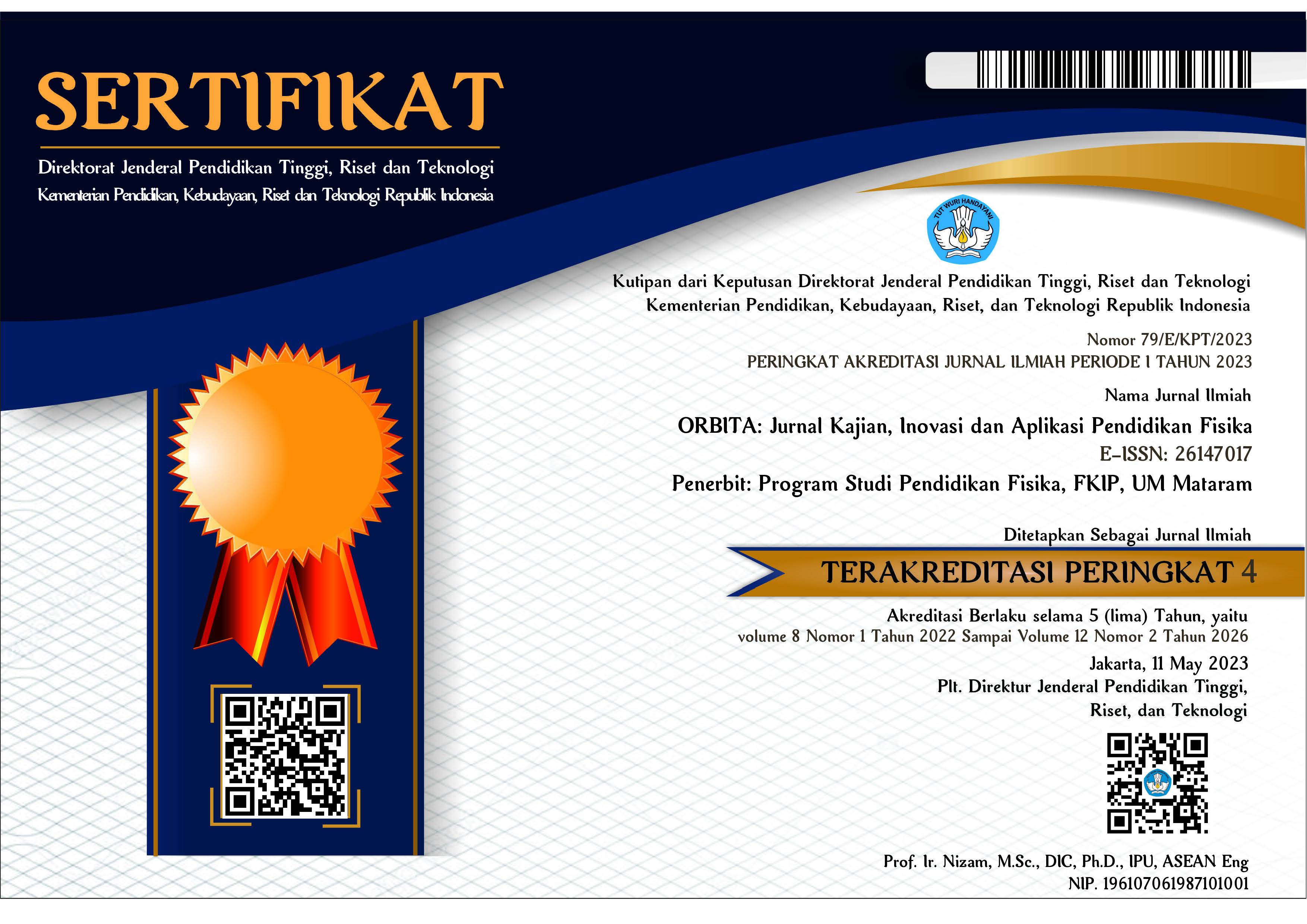PENERAPAN RAGAM MEDIA VISUAL UNTUK MENINGKATKAN LEVEL PEMAHAMAN KONSEP DAYA LISTRIK MAHASISWA CALON GURU FISIKA TAHUN AKADEMIK 2020/2021
Abstract
ABSTRAK
Penelitian penerapan ragam media visual untuk meningkatkan level pemahaman konsep rangkaian arus searah calon guru fisika telah dilakukan. Penelitian ini bertujuan untuk mengetahui apakah penerapan ragam media visual pada perkuliahan fisika dasar dapat lebih meningkatkan jumlah calon guru fisika yang mencapai level pemahaman konsep secara utuh dibanding penerapan pembelajaran konvensional. Metode penelitian yang digunakan pada penelitian ini adalah metode quasi eksperiment dengan pretest-posttest control group design. Populasi pada penelitian ini adalah seluruh mahasiswa semester satu yang program mata kuliah fisika dasar yang berjumlah 89 mahasiswa di salah satu perguruan tinggi di Sulawesi Selatan. Sampel dipilih 60 mahasiswa yang terbagi pada dua kelas yaitu kelas eksperimen dan kelas kontrol dengan jumlah pada masing-masing kelas yaitu 30 mahasiswa yang diambil secara acak kelas. Instrumen tes yang digunakan pada penelitian ini adalah instrumen tes level pemahaman konsep dalam bentuk uraian dengan mencakup 3 bagian soal, dua bagian soal yaitu soal 1 (S1) dan soal 2 (S2) menghendaki reaksi berbentuk deskripsi verbal serta satu bagian soal yaitu soal 3 (S3) menghendaki reaksi berbentuk deskripsi gambar. Hasil penelitian menunjukkan bahwa jumlah mahasiswa yang mencapai level pemahaman konsep yang utuh setelah mengikuti perkuliahan fisika dasar melalui penerapan ragam media visual lebih banyak daripada melalui penerapan pembelajaran konvensional. Dengan demikian, penerapan ragam media visual pada perkuliahan fisika dasar dapat lebih meningkatkan jumlah calon guru fisika yang mencapai level pemahaman konsep secara utuh dibanding penerapan pembelajaran konvensional.
Kata kunci: ragam media visual; level pemahaman konsep; rangkaian arus searah
ABSTRACT
Research on the application of various visual media to increase the level of understanding of the direct current circuit concept for pre-service physics teacher has been carried out. This study aims to determine whether the application of various visual media in basic physics lectures can further increase the number of pre-service physics teacher who reach the level of complete concept understanding compared to the application of conventional learning. The research method used in this study is a quasi-experimental method with a pretest-posttest control group design. The population in this study were all first semester students who took basic physics courses, totaling 89 students at a university in South Sulawesi. The sample was selected by 60 students who were divided into two classes, namely the experimental class and the control class, with the number of students in each class being 30 students who were taken at random. The test instrument used in this study was a concept understanding level test instrument in the form of a description, by covering 3 parts of the question, two parts of the question, namely question 1 (S1) and question 2 (S2) requiring a reaction in the form of a verbal description and one part of the question, namely question 3 (S3) requiring a reaction in the form of an image description. The results showed that the number of students who reached the level of complete concept understanding after attending basic physics lectures through the application of a variety of visual media was more than through the application of conventional learning. Thus, the application of various visual media in basic physics lectures can further increase the number of pre-service physics’ teacher who reach the level of complete concept understanding compared to the application of conventional learning.
Keywords: variety of visual media; level of concept understanding; direct current circuit
Keywords
Full Text:
PDFReferences
Abraham, M. R., Grzybowski, E. B., Renner, J. W., & Marek, E. A. (1992). Understandings and misunderstandings of eighth graders of four physics concepts found in textbooks. Journal of Research in Science Teaching, 29(2), 105–120. https://doi.org/10.1002/tea.3660270105
Asha, I. K., & Al Hawi, A. M. (2016). The impact of cooperative learning on developing the sixth grade students decision-making skill and academic achievement. Journal of Education and Practice, 7(10). http://search.ebscohost.com/login.aspx?direct=true&db=eric&AN=EJ1099599&site=ehost-live
Asli, S., Kortam, N., Algamal, S., Sheme, N., & Hugerat, M. (2021). The Decision-Making Ability of 10th Grade Students in an Arab Community in Israel to Preserve Sea Turtles. Eurasia Journal of Mathematics, Science and Technology Education, 17(3), 1–13. https://doi.org/10.29333/ejmste/9758
Aykutlu, I., & Sen, A. I. (2011). Using Analogies in Determining and Overcoming High School Students ’ Misconceptions about Electric Current. Necatibey Faculty of Education Electronic Journal of Science and Mathematics Education, 5(2), 221–251.
Çalik, M., & Ayas, A. (2005). A comparison of level of understanding of eighth-grade students and science student teachers related to selected chemistry concepts. Journal of Research in Science Teaching, 42(6), 638–667. https://doi.org/10.1002/tea.20076
Chiu, M. H., & Lin, J. W. (2005). Promoting fourth graders’ conceptual change of their understanding of electric current via multiple analogies. Journal of Research in Science Teaching, 42(4), 429–464. https://doi.org/10.1002/tea.20062
Evagorou, M., Jimenez-Aleixandre, M. P., & Osborne, J. (2012). “Should We Kill the Grey Squirrels?” A Study Exploring Students’ Justifications and Decision-Making. International Journal of Science Education, 34(3), 401–428. https://doi.org/10.1080/09500693.2011.619211
Fang, S. C., Hsu, Y. S., & Lin, S. S. (2018). Conceptualizing Socioscientific Decision Making from a Review of Research in Science Education. International Journal of Science and Mathematics Education, 17(3), 427–448. https://doi.org/10.1007/s10763-018-9890-2
Hadzigeorgiou, Y., Fokialis, P., & Kabouropoulou, M. (2012). Thinking about Creativity in Science Education. Creative Education, 03(05), 603–611. https://doi.org/10.4236/ce.2012.35089
Hidayah, N., & Dwikoranto. (2018). Guided Inquiry Learning Using Phet Simulations Based Worksheet to Improve Students’ Conceptual Understanding on Kinetic Theory of Gasses. Jurnal Inovasi Pendidikan Fisika, 07(02), 171–175. https://doi.org/10.26740/ipf.v7n2.p%25p
Lindahl, M. G., & Linder, C. (2015). What’s natural about nature? Deceptive concepts in socio-scientific decision-making. European Journal of Science and Mathematics Education, 3(3), 250–264. https://doi.org/10.30935/scimath/9435
Paraskeva-Hadjichambi, D., Hadjichambis, A. C., & Korfiatis, K. (2015). How Students’ values are intertwined with decisions in a socio-scientific issue. International Journal of Environmental and Science Education, 10(3), 493–513. https://doi.org/10.12973/ijese.2015.256a
Prasetyo, E. B., & Rusimamto, P. W. (2015). Pengembangan Media Pembelajaran Berbasis Visual Basic 6 . 0 pada Kompetensi Dasar Mendeskripsikan Elemen Pasif dalam Rangkaian Listrik Arus Searah di SMK Raden Patah Kota Mojokerto. Jurnal Pendidikan Teknik Elektro, 4(3), 1036–1040.
Sabrina, F., & Wasis. (2019). Implementation of Guided Discovery Learning Model Using Phet Simulations on Ideal Gas Materials in XI MIPA of State Senior High School 2 Nganjuk. Inovasi Pendidikan Fisika, 08(02), 535–539. https://doi.org/10.26740/ipf.v8n2.p%25p
Sinulingga, P., Hartanto, T. J., & Santoso, B. (2016). Implementasi Pembelajaran Fisika Berbantuan Media Simulasi PhET untuk Meningkatkan Hasil Belajar Siswa Pada Materi Listrik Dinamis. Jurnal Penelitian & Pengembangan Pendidikan Fisika, 2(1), 57–64. https://doi.org/10.21009/1.02109/1
Stevens, R. (2012). Identifying 21st Century Capabilities. International Journal of Learning and Change, 6(3/4), 123–137. https://doi.org/10.1504/IJLC.2012.050857
Westbrook, S. L., & Marek, E. A. (1992). A cross‐age study of student understanding of the concept of diffusion. Journal of Research in Science Teaching, 29(1), 51–61. https://doi.org/10.1002/tea.3660280803
Yanti, M., Ihsan, N., & Subaer. (2017). Development of Interactive Learning Media on Kinetic Gas Theory at SMAN 2 Takalar. Journal of Physics: Conference Series, 812. https://doi.org/10.1088/1742-6596/755/1/011001
Yusal, Y., Suhandi, A., Setiawan, W., & Kaniawati, I. (2021). The Effectiveness of Collaborative Problem-solving Using Decision-making Problems to Improve the Pre-service Physics Teachers’ Critical Thinking Skills. Jurnal Pendidikan Fisika, 9(2), 107–116. https://doi.org/10.26618/jpf.v9i2.5059
DOI: https://doi.org/10.31764/orbita.v8i1.8557
Refbacks
- There are currently no refbacks.

This work is licensed under a Creative Commons Attribution-ShareAlike 4.0 International License.
______________________________________________________
ORBITA: Jurnal Pendidikan dan Ilmu Fisika
p-ISSN 2460-9587 || e-ISSN 2614-7017
This work is licensed under a Creative Commons Attribution-ShareAlike 4.0 International License.
EDITORIAL OFFICE:


























